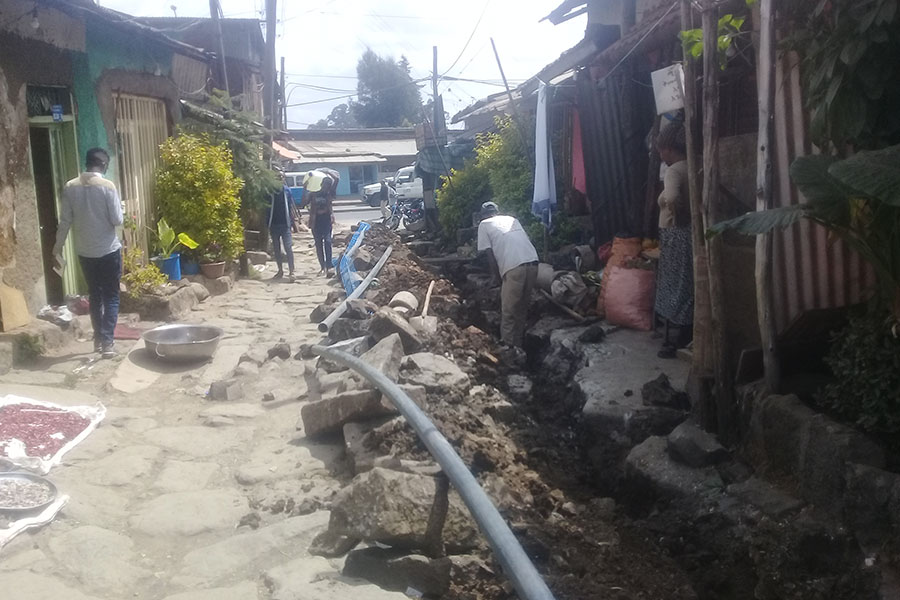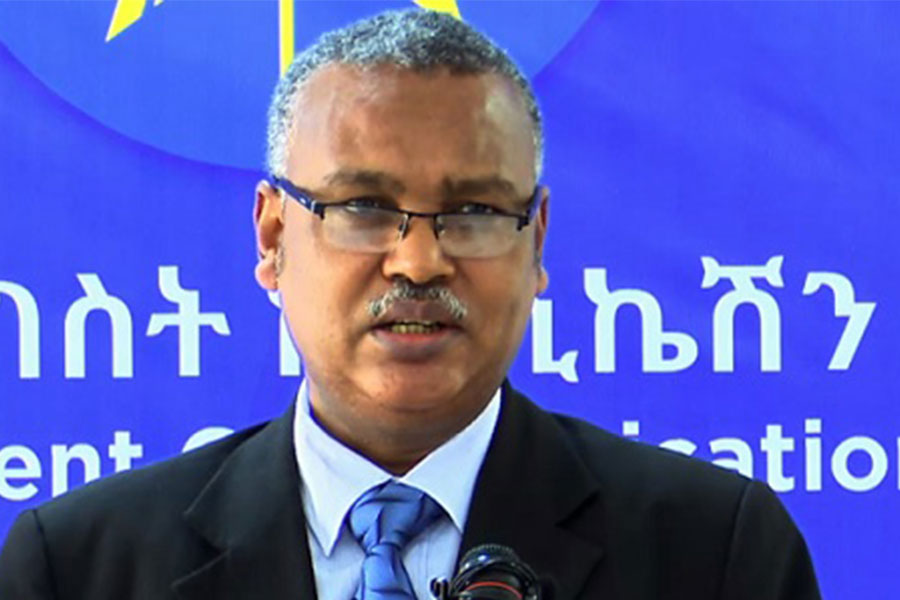
Radar | Jan 14,2023
Jan 23 , 2021.
The last time the ugly prospect of mass starvation stuck out its head, drought affected at least 20 million people across the country in 2015. Ethiopia was better prepared than at any time before in its history. Catastrophic outcomes were averted, with Ethiopia's own resources paying more than half of the funds required for emergency responses - a record in the country's history passed with no recognition of its monumental significance.
Usually, millions facing food insecurity in Ethiopia does not make headline news. Not because it is a small matter – not by a long shot. The social and political consequences of food insecurity could not be understated. But with a tenth of the population estimated to be chronically food insecure - close to 21 million in a recent assessment - it is an unfortunate but normal state of affairs for a low-income country. Not a year passed without having millions of Ethiopians finding themselves in the unfortunate food insecurity situation, hence under emergency humanitarian support programmes.
But for a famine to happen in a country, something other than the unavailability of food has to happen, according to Amartya Sen. The Nobel Laureate economist is known for his theory that "people very rarely die simply because there is not enough food to go round at the time of droughts." Rather, political decisions, coupled with economic structures and social networks, aggravate food crises and famines. Add to this a collective ignorance and lack of concern fueling a bad situation into a terrible stage.
Today, following an armed conflict in Tigray Regional State that sealed the area off for more than two months, Ethiopia is faced with the biggest humanitarian crisis in decades. Several overlapping issues make it likely that the problem will be the most acutest and unparalleled in recent history.
The last time the ugly prospect of mass starvation stuck out its head, drought affected at least 20 million people across the country in 2015. Ethiopia was better prepared than at any time before in its history. Catastrophic outcomes were averted, with Ethiopia's own resources paying more than half of the funds required for emergency responses - a record in the country's history passed with no recognition of its monumental significance.
But the web of problems facing Ethiopia is different this time around.
There has been the Novel Coronavirus (COVID-19) pandemic, which has led to lockdowns that depressed business activities, thus causing economic slowdown. Studies show that this alone slashed household food consumption as a result of job and income losses. Inflation that sent food prices soaring at around 20pc would be of little help, especially for the urban poor that depends on subsistence livelihoods. The Desert Locust outbreak struck the northern and eastern parts of the country for the second year in a row, leading to losses of crops planted over hundreds of thousands of hectares. The political instability that boiled over into community violence exacerbated the already alarming situation.
Under this ominous climate, armed conflict between the forces of the federal government and Tigray Regional State erupted. Large-scale violence is bad everywhere; it was likely to be worse there. The northern part of the country has historically been a scene to some of the most devastating famines. The most recent, in the mid-1980s, saw over a million people starve to death.
Ever since, matters have improved though the Tigray region continued to be food insecure and has one of the country's highest poverty prevalence rates. In the early 2010s, it was distinctive in being one of three regions that did not see a “statistically significant” decline in poverty rates even as the country was swinging double-digit growth in GDP, according to the World Bank’s poverty report. It also sees inflation above the national average.
The ongoing conflict, which blew over during a harvest season, can only exasperate this situation. Considering that access to the region remains extremely limited, and the Europeans suspended hard needed budget support due to a lack thereof, it has not been possible to make the required on-the-ground and accurate assessments of humanitarian support needs for millions of people in Tigray. But according to the picture being drawn by aid agencies, refugee testimonials and even members of the interim government, describing the unfolding situation in Tigray as "alarming," will only be an understatement.
The Tigray Emergency Coordination Centre estimates that 4.5 million people — comprising two-thirds of the population — now face emergency food assistance. About half are already displaced. while most hospitals are inaccessible and medicine is hard to come by. Despite reports of improvements in parts of the region, prices have skyrocketed in the cases where markets are open at all.
Famine is a real prospect in the region. The Famine Early Warning Systems Network warns "crisis" level outcomes, a designation two steps below famine, are expected. In the absence of humanitarian assistance, it can be raised to "emergency" level, just a step below the severest form of food insecurity.
There are several reasons why enough aid is still not reaching the region. Early surveys from the UN indicate sporadic fighting, especially in the country's rural parts, is still ongoing. This shows that there may not be a force remaining to challenge the federal government’s control, but it does not mean it is stable and safe enough to allow unhindered humanitarian aid to be accessed. Another factor is the government's restrictions on transportation, despite a memorandum of understanding signed with the United Nations to allow humanitarian assistance to reach those in need. Unfortunately, aid agencies have been complaining of bureaucratic hurdles.
Earlier this month, the 61pc of cargo and mission requests that were cleared took between five to 10 days.
“In some cases, partners could not travel to Tigray due to additional bureaucratic constraints at [local] levels, despite clearance received from federal authorities,” UN-OCHA reported.
No less contributory is destroyed infrastructure, first due to fighting, and then reported looting. It was only last week that the federal government announced power returned to major towns such as Adwa, Axum and Shire. Wukro and Adigrat hospitals – which could have come in handy for treating malnourished people - have been looted, according to the region’s interim Health Bureau head, Fasika Amdesellasie (MD).
The now obvious but murky involvement of Eritrean forces in Tigray further complicated an already messy situation. So does their role remain controversial if not unclear.
There is some good news but not nearly enough to inspire confidence in the people there. Humanitarian assistance, including food and medicine, has been delivered for 1.8 million beneficiaries across the region, with plans to expand this to 2.5 million people, authorities in Addis Abeba and Meqelle claim. But considering banks remain closed in several parts of the region, and communications and power lines are still intermittent, the continuing feeling of insecurity will last a while before the region returns to the level of self-sufficiency (however limited it might have been) it once had.
This requires a mobilisation effort to avert mass starvation.
It is appropriate to reckon that the state’s machinery was overnight oriented after November 4, 2020, toward what the government said was "an operation to save the country from disintegration." It unleashed a media campaign that trumpeted the cause's worthiness; mobilised funds from the public for the armed forces; and sent its diplomats in a drive to win the support of regional governments and those afar. Months have passed since federal authorities have declared victory. This should mean that a humanitarian one should replace the “law enforcement” operation. If mass starvation occurs, the government could no longer blame a conflict over which it has declared victory. The responsibility lies entirely on its shoulders.
Beginning engagement with the local population in rehabilitation can be a promising start. This will only happen when the rule of law is upheld and local customs and norms are respected. But if the local population is treated as hostile, relationships with the federal government could sour even further. The political elite, community leaders, civil servants and businesses would exclude themselves further from the effort to return to normalcy.
More than aid, it is also a return of business activities that would be most essential in avoiding a humanitarian crisis. It would alleviate the shortage if combined with the provision of safe and unhindered access to humanitarian aid. This requires a speedy resumption of the communication lines, power and clean water services, and banking. In their absence, aggregate demand cannot pick up, supplies will remain similarly stagnated, and inflation and hoarding will continue.
A usual counter-argument for allowing such access is that the TPLFites have a history of siphoning humanitarian aid for armed struggle. True or not, famine is a terrible price for a country to have on its conscience, even if it means that some of it may be misused. Allowing aid agencies may mean that certain things about the conflict could come to light. Still, even this should not be a reason to deny life-saving aid to a vulnerable population, many children, the elderly and the most in need.
The federal government has declared victory over most parts of the region. In effect, it has shouldered the responsibility to ensure that mass starvation does not occur. It should not be derelict in its duty now. Failure to do so will only bring accountability before the jurisdiction of the international level someday.
PUBLISHED ON
Jan 23,2021 [ VOL
21 , NO
1082]

Viewpoints | Jan 25,2020

Verbatim | Mar 11,2023

Viewpoints | Feb 06,2021

Radar | Jan 07,2022

Verbatim | Jan 07,2024

My Opinion | 132105 Views | Aug 14,2021

My Opinion | 128507 Views | Aug 21,2021

My Opinion | 126435 Views | Sep 10,2021

My Opinion | 124046 Views | Aug 07,2021

Dec 22 , 2024 . By TIZITA SHEWAFERAW
Charged with transforming colossal state-owned enterprises into modern and competitiv...

Aug 18 , 2024 . By AKSAH ITALO
Although predictable Yonas Zerihun's job in the ride-hailing service is not immune to...

Jul 28 , 2024 . By TIZITA SHEWAFERAW
Unhabitual, perhaps too many, Samuel Gebreyohannes, 38, used to occasionally enjoy a couple of beers at breakfast. However, he recently swit...

Jul 13 , 2024 . By AKSAH ITALO
Investors who rely on tractors, trucks, and field vehicles for commuting, transporting commodities, and f...

Jul 13 , 2025 . By YITBAREK GETACHEW
The Addis Abeba City Revenue Bureau has introduced a new directive set to reshape how...

Jul 13 , 2025 . By BEZAWIT HULUAGER
Addis Abeba has approved a record 350 billion Br budget for the 2025/26 fiscal year,...

Jul 13 , 2025 . By RUTH BERHANU
The Addis Abeba Revenue Bureau has scrapped a value-added tax (VAT) on unprocessed ve...

Jul 13 , 2025 . By NAHOM AYELE
Federal lawmakers have finally brought closure to a protracted and contentious tax de...